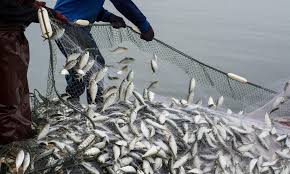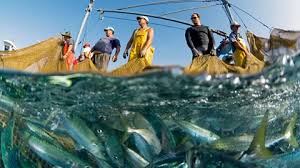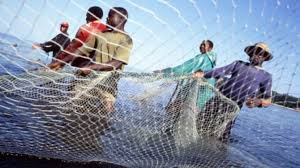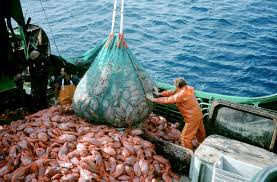Several stages occur during fisheries exploitation, such as underexploitation and overexploitation. Many fisheries are overexploited. In this article, these terms will be defined, different forms of overfishing will be discussed, effects of overexploitation will be outlined, principles of resource exploitation (Sutherland, 2001) will be explained, measures needed to exploit conservatively will be highlighted, and methods for assessing the exploitation level will be described.
Definitions of Exploitation Stages in Fisheries

Under intense exploitation, most fisheries experience the following sequence: undeveloped, developing, fully exploited, overexploited, collapsed, and with appropriate management measures, rebuilding.
1. Underexploited fisheries: refer to underdeveloped or new fisheries. This is believed to have significant potential for expansion in production.
2. Moderately exploited fisheries: are those that are exploited with a low level of fishing. They have some limited potential for expansion in total production.
3. Fully exploited fisheries: The fishery is operating at or close to an optimal yield level with no expected room for further expansion.
4. Overexploited fisheries: Fisheries are exploited at or above a sustainable level in the long term with no room for further expansion and are at risk of collapse or stock depletion. Overexploitation or overfishing is the removal of aquatic living resources to levels that cannot sustain viable populations.
Overexploitation can lead to resource depletion, threaten or endanger species of fish or wildlife. Overexploitation affects fisheries directly and indirectly. Direct effects are associated with target and bycatch species.
Forms of Overfishing
According to the Community-Based Coastal Resource Management Centre (2003), there are different forms of overfishing, including:
1. Economic overfishing: Increasing fishing intensity does not translate to more catch or profit. There is a maximum level at which the environment can produce. When the limits of production are reached, catches begin to reduce. If fishing intensity increases, fishing costs such as labor, materials, capital, and fuel increase. If the catch is greater than the cost, there is a profit or resource rent (Total catch – Total costs).
2. Recruitment overfishing: This occurs when fishing is so intense that the parent stock is reduced in numbers and can no longer produce a normal stock in the next year. This can be prevented by the provision of sanctuaries for such fish. This affects the ability of the species to replenish the population. Gears can physically disturb the habitats and sediments, catching both target and non-target species.
3. Growth overfishing: This occurs when fish are caught at an uneconomic size; for instance, when a lot of small-sized fish are caught in the absence of large fish. This form of overfishing occurs at the species level.
4. Ecosystem overfishing: This occurs when several species are overfished. It is difficult to understand when ecosystem overfishing occurs because when one species is overfished, another one will take over, but eventually, the ones that take over may also become consumed.
There are three ways an ecosystem can be overfished: destruction of the primary producers such as mangroves, coral reefs, sea grass beds; decrease in secondary producers; decrease in primary producers and decrease in biomass of the fisheries.
5. Malthusian overfishing: Limited resources cannot support increasing populations. This implies that fish are being harvested beyond the maximum sustainable yield.
Read Also: 15 Medicinal Health Benefits Of Echinacea purpurea (Purple Coneflower)
Effects of Overexploitation

Indirect effects of overfishing or overexploitation include ghost fishing, where a fishing gear left or lost at sea continues to fish or restrict the movement of fish, causing starvation, laceration, suffocation, and infection. Indirect effects also cause trophic cascading effects in which top-level predators are removed, affecting the entire ecosystem.
Overfishing has decreased catches for many fisheries, negatively impacted ecosystem health, and harmed the sustainability of stocks. Human food supplies are reduced due to the reduction in catches. Overexploited fisheries may be unable to meet the demand for fish oils.
Depleted fisheries have stocks with catches well below historical levels, irrespective of the amount of fishing effort being exerted. Recovering fisheries are those with increasing catches after being depleted. They are yielding less than their maximum potential owing to excessive fishing pressure in the past. According to FAO (2008), 2%, 52%, 19%, 8%, and 1% of the fish stock were underexploited, fully exploited, overexploited, depleted, and recovering, respectively.
Principles of Resource Exploitation (Sutherland, 2001)
Population increase can be exploited, and populations should be exploited at the rate they increase (Caughley & Gunn, 1995).
Density dependence is essential. If due to density dependence, reduction in population causes an increase in breeding output or survival, then the resulting increase may be exploited. Density dependence is central to sustainable exploitation (Ricker 1954, Schaefer 1954). Quantifying density dependence is difficult to measure because of sampling errors (Shenk et al, 1998).
Sustainable exploitation involves reducing population size and depends on a growing population, which can be achieved by reducing populations to take advantage of the density-dependent increase in survival or breeding output. Exploited populations must be lower, even when exploited sustainably. Sustainability has many conflicting definitions depending on the objectives.
It is better to monitor the population than the harvest. It is easier to measure changes in the number of individuals exploited, but determining changes in population sizes is better for adjusting the exploitation level (Lande et al., 1997). It is the population size that really matters.
Quotas are unstable. Populations fluctuate, estimates of a sustainable quota may be faulty, or the quota may be exceeded. When the population declines, the quota becomes an increasing proportion of those remaining, which can drive the population further downward. Monitoring can prevent overexploitation. There is a natural variation in the population size, and it is difficult to reduce agreed quotas.
Increasing effort is simple, but reducing it is painful. Overexploitation of populations continues even when reducing effort should produce greater long-term yield (Ludwig et al., 1993).
Read Also: The Health Benefits of Using Accent Seasoning on your Cooking
Measures Needed to Exploit Conservatively

i. It is better to restrict effort rather than quotas.
ii. Only exploit populations when they exceed a threshold size (Lande et al, 1997).
iii. Adopt rotational management in which areas are exploited for a period and then left (Myers et al., 2000).
iv. Establish exclusion zones where fishing is not allowed (McCullough, 1996).
v. Protect gravid and juvenile individuals.
vi. Protect water from pollution.
vii. Include fisheries impact assessments in environmental impact assessments for activities that impact fishery or other aquatic resources.
Methods for Assessing Exploitation Level
1. Surplus production method: This method determines how catch varies with effort. Data required are the numbers or biomass exploited per year and effort. This method has been used mainly for fisheries.
2. Yield per recruit method: This method considers recruitment in determining a long-term sustainable strategy. It is used mainly for fisheries and forestry.
3. Robinson and Bedford model: This method entails the calculation of maximum growth and yield if the population is 0.6 of the expected population size. The data required include average age at first reproduction, annual birth rate, and age at last reproduction. This method is used when little is known about a species and has been applied mainly to tropical forest mammals and birds.
4. Linking yield to recruitment and mortality: Data required for this method are recruitment and mortality rates. No data are needed for trends or effort. It does not apply to populations in equilibrium, only to populations at sustainable population sizes. This method is used occasionally for mammals.
5. Adjusting to population changes: This method loosens and tightens regulations to adjust to population changes. It demands very little data on population. It emphasizes population sizes but may be difficult to respond to environmental changes.
6. Comparing demography across sites: This method relates exploitation intensity to density or population change. The data required are exploitation level and population density (or population change at a range of sites). This method focuses on populations and can be carried out in the short term without detailed ecological studies. It is necessary to know whether results are affected by other interactions, such as environmental factors.
7. Reducing to a fixed fraction of the exploited population size: This method maintains the population at a proportion of, for example, 60% of the unexploited population. Data required include the likely unexploited population size and the current population size. This method is useful for data-deficient populations. However, the method requires estimates of unexploited populations and is difficult to use for variable populations.
8. Full population model: Creates a full model of major components of the population and examines the consequences of different harvest levels. It requires full data on the strength of all density-dependent processes. It is considered one of the best methods and can be used to examine the consequences of other changes.
9. Adaptive management: This method uses models to identify uncertainties and tests experiments to reduce these doubts. It involves continually improving knowledge and management through the use of data from experiments. The main strength is the continuous improvement of knowledge.
Do you have any questions, suggestions, or contributions? If so, please feel free to use the comment box below to share your thoughts. We also encourage you to kindly share this information with others who might benefit from it. Since we can’t reach everyone at once, we truly appreciate your help in spreading the word. Thank you so much for your support and for sharing!
Read Also: How to Properly Dispose Yard Paper Waste Bags
Frequently Asked Questions
We will update this section soon.

